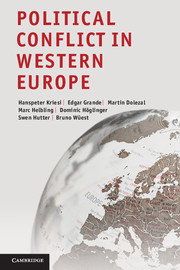Book contents
- Frontmatter
- Contents
- List of Figures
- List of Tables
- Preface and acknowledgments
- Part I Theory and methods
- Part II The development of the ‘integration–demarcation’ cleavage
- 3 Participation and party choice: comparing the demand side of the new cleavage across arenas
- 4 Restructuring the national political space: the supply side of national electoral politics
- 5 Restructuring the European political space: the supply side of European electoral politics
- 6 Restructuring protest politics: the terrain of cultural winners
- 7 Congruence, counterweight, or different logics? Comparing electoral and protest politics
- Part III Public debates: the articulation of the new cleavage in detail
- Part IV Conclusion
- References
- Index
6 - Restructuring protest politics: the terrain of cultural winners
Published online by Cambridge University Press: 05 August 2012
- Frontmatter
- Contents
- List of Figures
- List of Tables
- Preface and acknowledgments
- Part I Theory and methods
- Part II The development of the ‘integration–demarcation’ cleavage
- 3 Participation and party choice: comparing the demand side of the new cleavage across arenas
- 4 Restructuring the national political space: the supply side of national electoral politics
- 5 Restructuring the European political space: the supply side of European electoral politics
- 6 Restructuring protest politics: the terrain of cultural winners
- 7 Congruence, counterweight, or different logics? Comparing electoral and protest politics
- Part III Public debates: the articulation of the new cleavage in detail
- Part IV Conclusion
- References
- Index
Summary
Introduction
During the last thirty years, research on political participation and social movements broadened the horizon of political scientists by focusing not only on the electoral arena but also on less institutionalized sites of mobilization (Kriesi 2008b). The present volume does so as well. Following Rucht (2007: 708), we define protest politics as ‘the deliberate and public use of protest by groups or organizations (but rarely individuals) that seek to influence a political decision or process’. Generally, such activities are treated as a seismograph of emerging or previously under-articulated societal demands. More specifically, scholars regarded the protests of the new social movements in the 1970s and 1980s as triggers for the first transformation of the cultural dimension, and the study of protest politics in that context was closely linked to the analysis of changing cleavage structures (e.g. Inglehart 1977; Kriesi 1989; Müller-Rommel 1984; Offe 1985).
The challenge posed by the populist right figures far less prominently in the literature on protest and social movements. Rydgren (2007: 257) even speaks of ‘a rather strict division of labor between scholars studying the new social movements and scholars studying the new radical right’. The present chapter works to link these two research strands by asking whether and how the protest politics arena has changed due to the new structural conflicts brought about by globalization. This allows us to test our hypotheses introduced in Chapter 1 about the conflict intensity and the contents of conflict in different political arenas, and to see what we would have missed had we only focused on electoral politics as in our first volume.
- Type
- Chapter
- Information
- Political Conflict in Western Europe , pp. 151 - 181Publisher: Cambridge University PressPrint publication year: 2012
- 7
- Cited by



